#Water Wednesday
Text
aquarium docent training on water wednesday!!!
8 notes
·
View notes
Text
A quick reminder for those observing Wash Your Water Bottle Wednesday: if your water bottle has a straw or a spout, give it some extra attention! Get in there and scrub the crap out! Use a little straw-cleaning brush if you've got one--you can generally find them at the grocery store--but even a craft pipe cleaner or just a little stick can help! The critters that might be living on the hard plastic walls of your water bottle are nothing compared to the nightmare monsters being incubated in the warm embrace of a silicone mouthpiece.
1K notes
·
View notes
Text

Hearts will dream again
Lungs will breathe in
Wash away the sins
It's where it begins
Feet won't fail you now
Arms won't let you down
Wash away the sins
It's where it begins
#wincest wednesday#fulfilling the prompt for the server i'm in#but its thursday#Under The Water by AURORA#samdean#wincest#sketch#the epic love story of sam and dean#supernatural#supernatural fanart#🐭
455 notes
·
View notes
Text


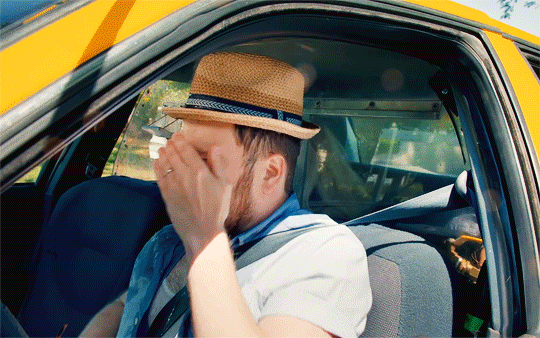

since it's summer it's the perfect time to listen to summer days feat. patrick stump :)
#patrick stump#fall out boy#kind of#my gifs#wet beast wednesday continues#how do i get the job of dumping buckets of water on his chest#👁️👁️#*
968 notes
·
View notes
Text


SPARKLE ON ✨✨✨
#project sekai#pjsk#prsk#emu otori#gif#blinking#proseka#sparkle on!#i was gonna queue this for wednesday but thats so painful for me so happy wonderhoy its wednesday sunday#kirakira dokidoki mochimochi puyopuyo wakuwaku wasshoi#i went through hell and high water and like 8 online free glutterbtext gif generator websites to find the exact font#thank you glittertextonline dot com#ive thought about drawing a lot of jerma bullshit as wxs. plesde be thankful that im focusing on artfight#the nene985 dollhouse is still on my mind. i wanna draw her leaping out of that window really bad#idk what to type here since this is like a week i advance and i wont remember scheduling this in about 20 minutes. ummmm#OHHH I HOPE MY GUITAR IS FIXED BY THE TIME THIS POSTS I FOUND A USED AMP FOR MY BIRTHDAY ^___^ I WANNA PLAY YIPPEEEEE#anyways.... be who you are. shalalalaaaa ^_^
1K notes
·
View notes
Text
Wet Beast Wednesday: tardigrades
Last week on Wet Beast Wednesday I covered the largest animals to ever exist on our planet. This week I'm going to pull a full 180 and cover the smallest animals yet on this series. Meet the tardigrade, the internet's favorite micro-animal the is said to be basically immortal. How true is that? Let's see.

(Image: an electron microscope image of a tardigrade. It looks a lot like a potato with eight stubby legs tipped with long claws. At the front is a small, circular mouth. It has no other discernable features. In the background are bits of plant matter that look like seaweed at this scale. End ID)
The tardigrades are 1,300 known species (and probably a lot of unknown ones too) in the phylum Tardigrada. They are also part of the superphylum Ecdysozoa, which are animals that grow by molting their outer cuticles or exoskeletons. In particular, the tardigrades are believed to be a sister group of the arthropods, the group that contains crustaceans, insects, isopods, and a lot of other things. Tardigrades are truly tiny, the largest species reaching a whopping 1.5 millimeters in length, though most species reach no more than 0.5 mm. They have round, segmented bodies with four pairs of legs that end in either claws or suction discs. The body segments consist of a head, three body segments with a pair of legs each, and a caudal segment with the final pair of legs. The first three legs are used for movement while the final pair points backwards and is used for grabbing onto substrate. All of the body segments except for the final one correspond to segments found in the head section of insects. Tardigrades are missing many hox genes, genes that direct the body plan during development. Their ancestors may have had a body plan more similar to insects, but the loss of the hox genes has compressed them into walking heads with a bit of butt. The mouth is tubular and sucks in food. In the mouth are stylets, needle-like structures used to pierce food objects. Once food is drawn into the mouth, a structure called the buccopharyngeal apparatus activates. This is a combination of spines and muscle that acts like an inner jaw that pulls food into the digestive tract. The buccopharyngeal apparatus is distinct enough to be used as a major identifying feature between species. Tardigrades are translucent and many images you've seen of them have false color to show the details or are 3D models based on scanning electron microscope imagery of them. Tardigrades molt their exoskeletons multiple times (up to 12) during their lifecycle. Some species are unable to poop normally and instead all their waste is discarded during the molt. It was formerly believed that tardigrades could exchange genes with each other without mating, a process called horizontal gene transfer that is seen in bacteria, archaea, and other micro-organisms. It has since been discovered that while still capable of horizontal gene transfer, it is quite a bit rarer in tardigrades than we thought.
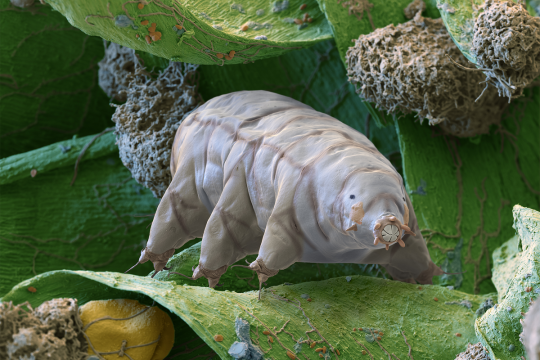
(Image: an electron microscope image of a tardigrade standing on a bit of plant matter. This one has a closed mouth with a ring of triangular tooth-like structures. It also has two simple eyes that look like black dots. End ID)
The name "tardigrade" means "slow walker", which is fitting as, despite their eight legs, tardigrades have a slow and awkward gait. This is the result of their legs being unjointed, only able to pivot at their connection to the body. Their gait has been compared to that of bears, hence why they are often called water bears and their discoverer, Johann August Ephraim Goeze, called them "kleiner wasserbär", meaning "little water bear". Tardigrades are found worldwide and have inhabited virtually every habitat, from the tops of mountains to the deep sea, from hot springs to the antarctic, from freshwater to saltwater. The one thing they have in common is a need to stay wet. Tardigrades can survive out of water as long as they can stay moist and are often found in mosses, hence another common name: moss piglets. The majority either eat plants or bacteria, but some will feed on smaller tardigrades or other micro-animals. Their famous survivability makes it easy for tardigrades or their eggs to be carried to new habitats by larger animals or other phenomena. Tardigrades are one of the first micro-animals to colonize a new habitat and they are a pioneer species, the first species to colonize a new environment and whose presence makes that environment fore suitable for other species to follow. Tardigrades are a major food source to other micro-animals and larger organisms. Most species have distinct males and females, though a few reproduce through parthenogenesis. In most cases, molting female will lay her eggs in her shed cuticle and males will them fertilize them. Other species have a form of internal reproduction. Males and females will court each other before mating and females will usually allow multiple males to fertilize her eggs. Female tardigrades are typically larger and more abundant than males. Eggs can take up to 14 days (species dependent) before hatching. All tardigrades of the same species have the exact same number of cells as each other. They are also born with the same number of cells they will have as an adult. Their growth is driven by enlargement of the existing cells rather than cellular reproduction making new cells. The lifespan ranges between a few months to a few years, depending on species.

(Image: a color photo of a tardigrade. It is a pale, translucent white, making it hard to make out details. Its body is curved, with the front end pointing at the camera. It has two simple eyes. End ID)
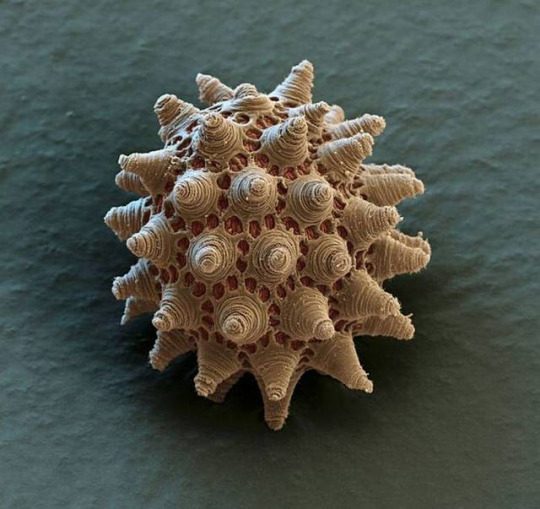
(Image: an electron microscope image of a tardigrade egg. It is round but covered in small pores and conical structures. End ID)
The most famous feature of tardigrades is their legendary durability. It is commonly said that tardigrades can survive just about anything (except for the things that are actually trying to kill them. They are prey to a lot of species after all). Among the things they can survive is extreme heat, extreme cold, dehydration, extremely high and low pressure, exposure to ionizing radiation (that's the scary kind), low oxygen environments, environmental toxins, heavy impacts, and the vacuum of fucking space. While the can survive in extreme conditions, tardigrades are not considered extremophiles. True extremophiles thrive in extreme environments and are negatively impacted by leaving them. Tardigrades can survive in extreme environments, but are negatively impacted and can't survive as well there as they can in less extreme places. The main trait that has allowed tardigrades to survive all five mass extinctions in history is cryptobiosis. Cryptobiosis is the rare ability for an animal to enter a state of dormancy where their metabolic processes come to an almost complete stop. While in cryptobiosis, metabolic activity drops to 0.01% normal and water content drops to 1% normal. In this state, the tardigrade is called a tun. Tardigrades usually enter cryptobiosis in response to arid conditions. One experiment showed that a species of tardigrade could last for at least 30 years in this state and return to normal lifestyle functions when exposed to water. Tardigrades will also enter cryptobiosis in response to low oxygen, toxic chemical exposure, increased or decreased temperature, and excessive salt content in the water. Tardigrades also show extreme resistance to both high and low pressure. They can live in 0 atmospheres of pressure and some species can survive up to 6,000 atmospheres, more than double the pressure at the bottom of the Marianas trench. More interesting is their ability to survive dangerous radiation. They can survive 1,000 times the dose of gamma radiation that humans can. Early tests focused on tardigrades in cryptobiosis and concluded that the extremely low water content of a cryptobiotic tardigrade doesn't leave much opportunity for the radiation to react with the animal. However it was later found that active and fully hydrated tardigrades are still considerably resistant to radiation. Studies into this resistance indicate that tardigrades can very efficiently repair damaged DNA and have unique proteins called Dsup that provides additional protection. Dsup introduced to human cells has provided additional protection against x-rays.
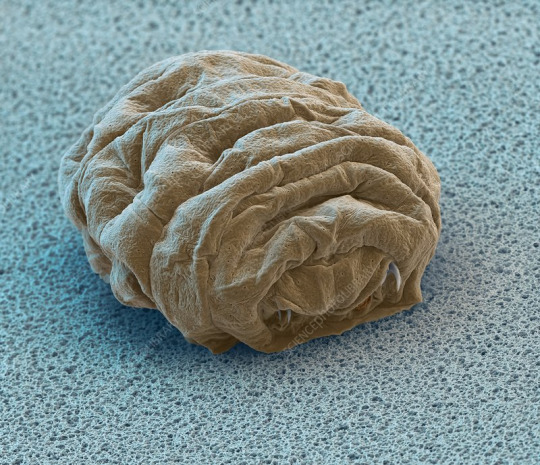
(Image: an electron microscope image of a tun - a tardigrade in cryptobiosis. It is smaller and very wrinkly, with the legs and mouth retracted into the body. End ID)
Tardigrades were the first animals to be exposed to the vacuum of space. They were exposed for 10 days, some in a state of cryptobiosis at the time of exposure and some still active. It was found that they were able to survive the vacuum when shielded from the sun's ultraviolet radiation, with those already in cryptobiosis doing better. Upon being rehydrated, many were able to resume normal life functions and successfully reproduce, though others died after being rehydrated. Those that were exposed to UV radiation fared much worse, with only a few hydrated individuals surviving. The individuals in cryptobiosis had a lower survival rate when exposed to UV than those not exposed to UV and were less successful at reproducing afterwards. Studies of tardigrade's space survival abilities and resistance to radiation could go a long way in helping human space travel. One of the largest dangers of space travel is that space is full of nasty radiation from the sun that Earth's magnetic field protects us from. Some scientists speculate about the possibility of accidentally seeding other planets or moons with tardigrades or other space-resistant organisms. This is a problem because introducing Earth life to other world has the potential to damage any native ecosystems and if we find life in space in the future we don't want to have to figure out if it's something we accidentally put there. While tardigrades could likely survive on other planets, they would eventually die without a food source. Some sources reported that tardigrades may have colonized the moon after an experiment with them crashed. Unfortunately, the moon is not crawling with tardigrades now. It's way too dry for them to exit cryptobiosis even if they survived the crash, which they probably didn't.
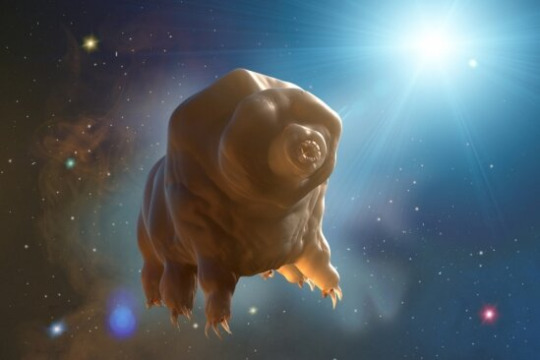
(Image: art of a tardigrade floating in the vacuum of space. End ID. Source: University of California - Santa Barbara)
#wet beast wednesday#tardigrade#water bear#moss piglet#micro animal#microbiology#marine biology#biology#zoology#ecology#animal facts#informative#science#space#astrobiology#radiation#cryptobiosis#tun#image described
155 notes
·
View notes
Text
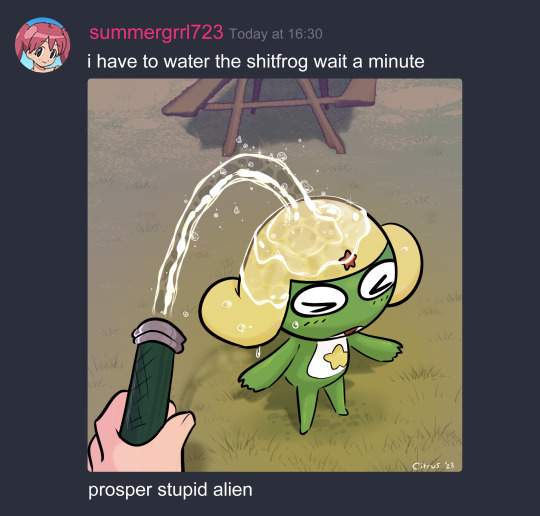
busy watering the frog
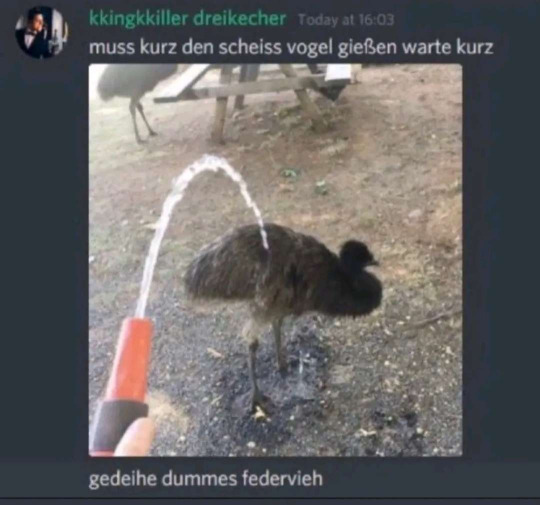
meme ref
#keroro gunso#keroro#myart#happy water his ass wednesday#i was goin for a gloopy ghibli water look but i mightve drawn it too thick? whatever. slime him i guess.
361 notes
·
View notes
Text
Sonic when he first met Tails: Fine I guess you can tag along if you think you're fast enough
Sonic couple of years later: I Would Die For You. I Would Kill For You. You Are The Most Precious Thing In My Life And It Hurts Me So Much Everytime You Remind Me You Don't See Yourself That Way. Whatever Apocalypse Happens The Thing I Care About The Most Is That You Are Well And Alive. I Would Fight And Swallow The Mass Of A Black Hole If It Was For You. You Are My Little Brother And No Higher Power Could Ever Hope To Separate Me From You For Good.
#sonic the hedgheog#you know I think that Sonic would find a way to swallow a black hole somehow#he'd find the magical rocks to do that#if its for tails he'd do it#hey treat yourself a glass of water for every ''you'' in this text#sonic#miles tails prower#tails the fox#wholesome sonic and tails wednesday#sonic & tails#unbreakable bond#silly brainworms
375 notes
·
View notes
Text

🌟❤️Sparkle on it’s Wednesday, from the Major!❤️🌟
#KIRA YEAHSSSSS#made this a little later#I love the major ❤️❤️❤️#happy wednesday!!#sparkle on!#star trek#ds9#star trek ds9#kira nerys#major kira#kira ds9#silly#tw flickering#tw flashing#have a great day!#drink water#Flashing
180 notes
·
View notes
Text
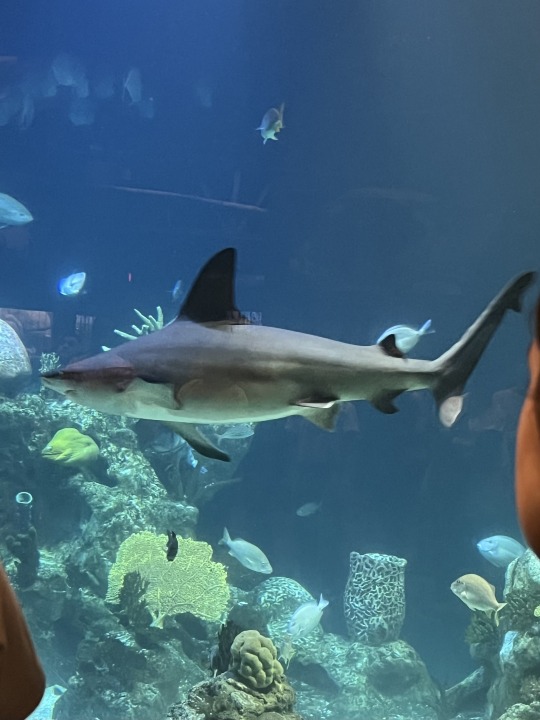

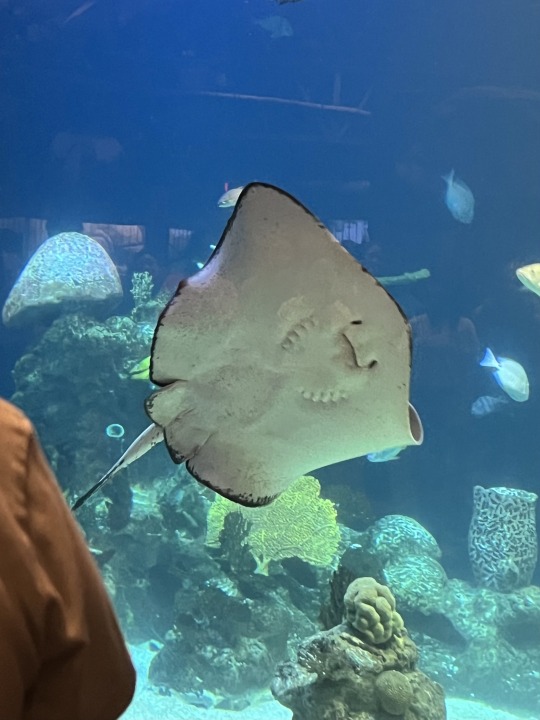
animales!!
[id: an image of a shark, a spotted ray, and a sting ray. end id]
5 notes
·
View notes
Text
Bianca criticizes Y/N on their fencing skills (comments timeline included)
Bianca: You're sloppy. You're gonna fail.
Y/N: Wednesday wouldn't allow that.
Bianca: Wednesday won't always be around. You need to improve your technique.
*Wednesday knocks on the nearby window*
Wednesday hold a sign up: Want me to kill them?
Y/n: Yes, my love. You may
Bianca: What the fuck?
Bianca: ...We’re 20 feet above ground and she isn’t using a ladder, how the fuck?
Y/n: Shhhh... She's amazing and you could be the one six feet under if you provoke her
*Wendsday nodding while trying to open the window with one hand*
Bianca: Ummm, no, but seriously there’s no windowsill for her to climb up and to keep her there and there’s no ladder? Did she glue herself or get somebody to throw her up there or are students just becoming a living ladder!?
Principal Weems: She climbed the wall like a spider...
Y/N: Spider baby
Bianca: …But how is she like spider-girl now or something? Does she have supernatural powers to do that? HOW DID WE NOT HEAR HER!?
Enid: She used to climb up the wall to Ophelia Hall after principle Weems put her on lockdown. She's just insanely silent
Y/N: is more like a talent now days... I still love her *dramatic in love sight*
Enid: I'm posting this video!
*Wendsday enters the room through window and Reader and Wednesday both chase enid*
Enid: Already posted!
Y/N: So you have chosen death?
Enid:.......Principle weems! Y/n is threatening me again!
Y/N: Technically, I'm using my girlfriend to threaten you...
*Wendsday pulling out knives*
Enid: THEYRE BOTH THREATENING ME!
Weems: It's your fault for posting the video but this does not mean you can kill her
Y/n: ......What if Wendsday just harms her?
Weems: ...... *Sight* just don't kill her......
*Weems walks away exasperated*
Bianca: ....I just wanted to do fencing
*Enid screams while she is being chased by Wendsday while Y/n laughs*
Enid: And I wanted two normal friends! I guess we are both disappointed! Xavier help me!!
Xavier: ye-
*Wednesday looks at him*
Xavier: YOUR ON YOUR OWN!
Everyone went at Enid's funeral because she thought she could out smart Y/N and out run Wendsday
The end
@snakeskins-world
@greatsharkboi
#male reader#gender nuetral reader#female reader#wednesday addams x male reader#wednesday addams x reader#wednesday addams x female reader#netflix wednesday#wednesday incorrect quotes#source: water boy
679 notes
·
View notes
Text
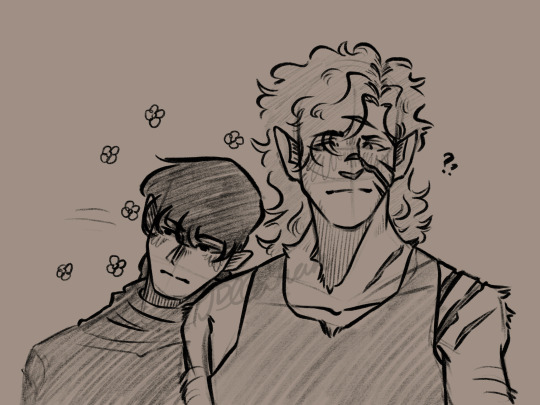
#drawing#wenclair#wednsday addams#enid sinclair#wednesday is soft for enid#incorrect wenclair#enid emma myers#enid fanart#werewolf#wednesday x enid#Enid is a little confused#but happy nonetheless#this is shortly post Tyler’s ass kicking#maybe just after Enid got patched up?#Enid is so fluffy#Enid is also a human hot water bottle#Wednesday is no doubt freezing her ass of without her#I love Enid’s scars#who doesn’t love messing with their baby girls?#enid x wednesday#wendesday netflix#wenclair art#my art
119 notes
·
View notes
Text
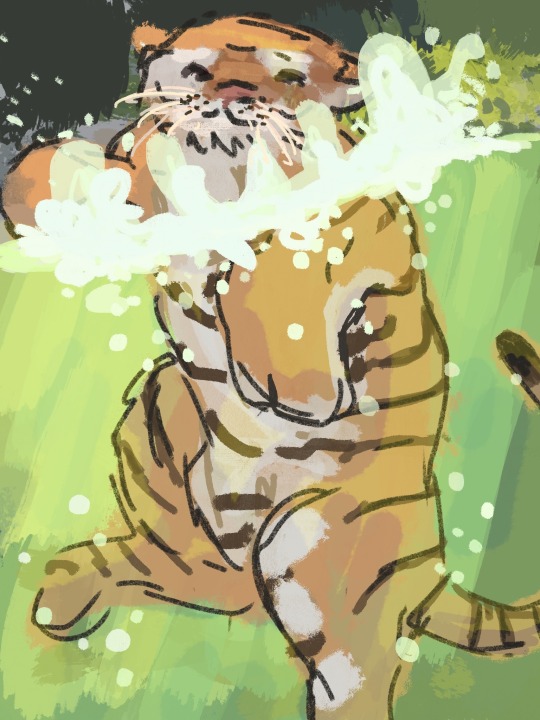
28.12.2022
Last wet beast Wednesday of 2022 😭😭😭😭😭
#wet beast wednesday#tiger#sopping wet#I will miss this :’(#year of the water tiger#eater tiger#year of the tiger#tiger art#speedpaint#digital media#iPad art#Procreate app#swimming tiger#happy tiger#cute
739 notes
·
View notes
Text


This is so Pisces and Scorpio coded.
58 notes
·
View notes
Text
@daffi-990 @lover-of-mine @devirnis tagged me in wip Wednesday! Look I promise this thing is going to have a happy ending
The sob that rips out of him hurts, like debris is getting lodged on his insides on the way out. He crumples like wet tissue, slumping onto Maddie who somehow manages to keep him upright. “Oh, Evan,” she says, holding on so tight. “Oh, honey, we’ll figure it out. We’re all going to be right here for you. You aren’t alone.” Isn’t he? Hasn’t he been left alone? How is he ever going to know where his shoulder is supposed to be without Eddie’s there to bump against? “And- and he could still be out there, maybe they’ll-“
”No.” the word is choked and violent, and his body tears itself back a step. “Maddie, stop.” He’s shaking his head, maybe. “He’s- I can’t think that. If he’s- if he’s-“ how did the ocean find him here? Why is he underwater? “I can’t do anything about it. It means I-I- I gave up, I left him-“ if Eddie is, somehow, still alive out on the open ocean he won’t be for long, and the thought of finding out later that something could have been done if only, if only- it floods his mouth with bile, makes his words come out sharp. “He has to be dead. I can’t- I can’t hope, Maddie, it will kill me.”
“Buck…”
She looks sort of horrified. Buck isn’t sure about which part, but he can’t spare any thought to figure it out because- “Eddie’s dead. E-Eddie’s dead. He’s dead, he- I can’t do this, I can’t- I can’t fucking look at anyone, I don’t want-“ huh, he can’t really see. “I don’t want to- to talk to anyone, I can’t- they’re going to bring casseroles a-and I’m going to have to answer the door and say thank you and we’ll- we’ll- there’ll be too much food in the fridge because that’s what happens when people die and I- I can’t- I can’t do this- I can’t do this-”
Very faintly, he is aware of hands on his body, moving him, sitting down. He wishes desperately for a moment that it had been him that died, but then thinks about Eddie still alive and feeling all this. He’s still a stoic man, all that therapy and effort to share what he’s feeling aside, and he thinks no one might realize right away how bad he was hurting if Buck wasn’t there to see it. At least Buck does this, explodes all over hospital waiting rooms or Bobby’s house or Maddie’s, and everyone can see the gooey pieces of him melting into the cracks and staining the carpet. Somebody’s got a shop vacuum somewhere probably, labeled with his name and in case of emergency.
Tagging @bigfootsmom @alliaskisthepossibilityoflove @eddiebabygirldiaz @chronicowboy @homerforsure @rewritetheending @shitouttabuck
#someone in the tags on one of these snippets was like buck wont give up he wont believe that eddies dead#and i was like uh oh. well. unfortunately not this time#he might be the most convinced that Eddie is dead because of all of the above#cannot physically consider any alternative it will rip him apart#tag games#wip wednesday#the going water and the gone
76 notes
·
View notes
Text
Today's Wet Beast Wednesday is about sea otters. I was originally going to do this last week in honor of the 24th birthday of Rosa, the world's oldest sea otter (and one of the oldest sea otters on record) but, well, I forgot. But better late than never.
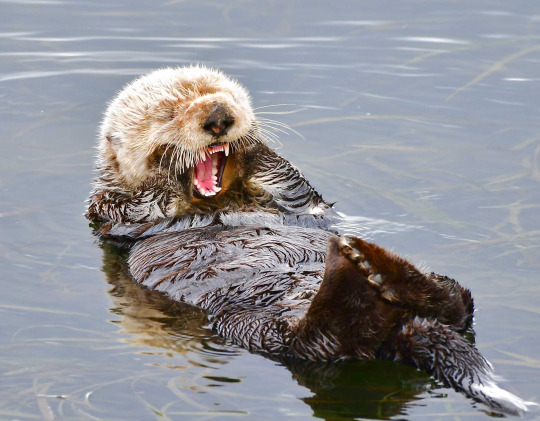
(Image: a sea otter on its back, yawning)
The sea otter (Enhydra lutris) is one of only two otters to live in salt water, the other being the rare and poorly-understood marine otter (Lontra felina). Otters are aquatic mammals of the family Mustelidae, which makes them cousins to weasels, badgers, wolverines, and martens. While many mustelids can swim, otters have adapted to a primarily aquatic lifestyle. Sea otters are divided into three subspecies: the Asian sea otter (Enhydra lutris lutris) which lives from northernmost Japan up through the northwest Pacific, northern sea otter (E. l. kenyoni) which lives from Alaska down to Oregon, and the southern sea otter (E. l. nereis), found in California.
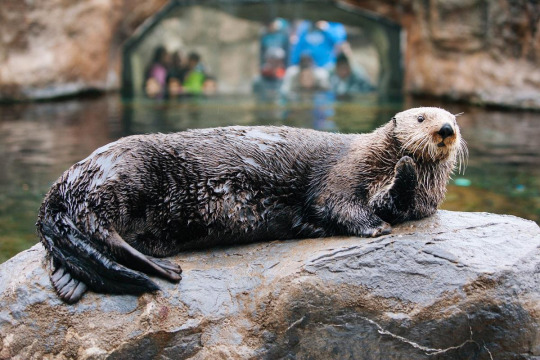
(image: a sea otter relaxing on a rock)
The sea otter is one of the smallest marine mammals (only the marine otter is smaller), yet it is also the heaviest of all mustelids. Males are larger than females, averaging between 1.2 and 1.5 meters (3'11" to 4'11") and 22 to 45 kg (49 to 99 lbs). Females average 1 to 1.4 m (3'3" to 4'7") and 14 to 33 kg (31 to 73 lbs). I honestly thought they were around the size of cats and was surprised to find out how big they can get. Otters are the most recent of the marine mammals and have not developed the thick layer of blubber other marine mammals use to keep themselves warm. Instead, sea otters warm themselves with the densest fur of any mammal, with almost a million hairs per square inch. The fur has two distinct layers: a longer layer of waterproof guard hairs and a shorter underfur layer. The guard hairs keep the underfur dry and trap air between the layers. This air gets heated by the otters body heat and provides an extra layer of insulation. This is the same principle that wet suits work on. The air layer also provides some added buoyancy. Sea otters are positively buoyant and can float on the surface of the water. There are many other adaptations to an aquatic lifestyle that sea otter have. Their feet are webbed and have long digits, allowing them to act as flippers but also making them slower and more clumsy on land. The front claws have retractable claws and pads that let them grab onto slippery objects. When swimming, they use their entire real bodies, but primarily their hind feet, for propulsion. They can hold their breath for up to five minutes and have whiskers used to search for food in darker water. Their ears and nostrils close when submerged to keep water out. While sea otter can, and often do, move around on land, they are capable of living their entire lives in the water. Some evolutionary biologists think sea otters represent an early stage of marine mammal development and can compare them to more established marine mammals like cetaceans and pinnipeds.

(image: a wet weasel holding a sea urchin)
Sea otters are carnivores whose diet consists mostly of hard-shelled invertebrates, though they will also eat fish. They forage for food on the sea floor in dives that usually last a minute. Their paws give them an advantage over other marine mammals, who can only use their mouths for capturing prey. Otters by contrast can pick up and move rocks and dig into the sediment. They are the only marine mammals to catch prey with their paws instead of teeth. Otters carry prey to the surface and eat while floating on their backs. Famously, they use rocks to break open the hard shells of their prey, making them one of the relatively few mammals to use tools (though tool use is proving to be more common than previously thought). Under each arm is a pouch of loose skin that is used to hold prey and rocks. Each otter has a favorite rock that they carry with them. Sea otters have blunt teeth used to crush through prey's shells.

(image: an otter dining on crab)
While sea otters do spend a lot of time in groups, they are not considered truly social animals as they forage, groom, and defend themselves on their own instead of with help. Groups of otters are called rafts that typically have between 10 and 100 members, but can reach up to 2000 members. Rafts are single sex, each having only male or female members. When resting, raft members will hold hands to keep themselves from drifting apart. One social behavior they engage in is play, which is done frequently. Mating season happens in autumn. During summer and autumn, males will attempt to establish territories and push other males out. Females mover between territories at will. Males without territories will swim around and attempt to find females in heat. Males will attempt to mate with multiple females. During estrus, the males and females will bond through play and sometimes aggressive behavior. When mating, the male will bite the female's head, which can leave scars. Otters are capable of delayed embryo implantation, where they can wait for several months between conception and the embryo beginning development. Pregnancy lasts four months and typically results in a single pup. While males are absentee fathers, females are very caring mothers who spend almost all their time caring for their pups. The only time she leaves her pup will be when diving. The pup will be left floating on the surface, often wrapped with kelp to keep it from floating away. The baby will cry for its mother until she comes back. The mother will teach her pup how to dive and forage as it ages. Pups will stay with their mothers for 6 to 8 months (longer in colder areas), and sometimes until they are fully developed. Childless females will foster orphaned pups. Females reach sexual maturity at age 3-4 and males around age 5. They average 10 - 15 years in the wild and can live significantly longer in captivity. The oldest living sea otter is Rosa, living in the Monterey Bay Aquarium, who is 24 years old. The oldest sea otter on record was a female named Etika who lived to be 28.
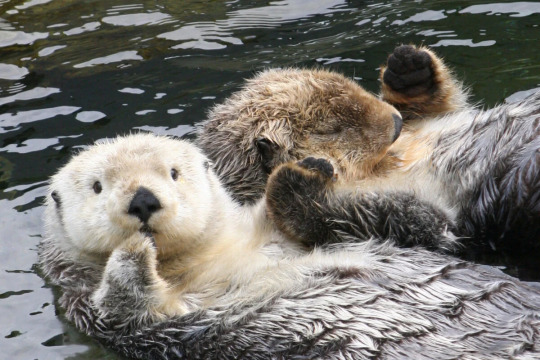
(image: two sea otters holding hands)
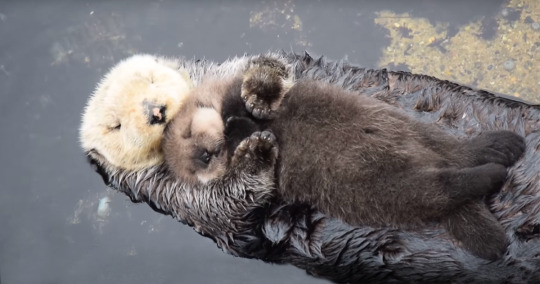
(image: a sea otter mother sleeping with its baby on its stomach)
Sea otters are a classic example of an endangered species. They have been hunted throughout history for their fur. Eventually, this reduced the world population to less than 2000 individuals. They are now the target of conservation measures worldwide and local and international protections, which has helped the population rebound. They still have not regained their historical population or range, though reintroduction measures have helped them reestablish in historical territories. The southern sea otters are the most endangered. Famously, almost all southern sea otters alive today are descended from a group of 50 discovered in 1938, when the subspecies was almost extinct. Sea otters are classified as endangered by the IUCN. Sea otters are a keystone species, having a major ecological impact on their habitats. Famously in California, the near-extinction of southern sea otters resulted in a population boon of sea urchins (their primary prey) which proceeded to kill vast areas of kelp forest. Curren threats include predation, pollution, and habitat loss. Oil spills are particularly devastating to sea otters, as the oil destroys the air layer in their fur, destroying their ability to keep themselves warm.
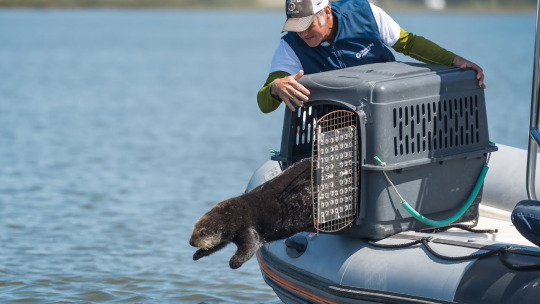
(image: an employee with MBARI releasing a rehabilitated sea otter back into the wild)
#wet beast wednesday#sea otter#otter#marine mammals#wet weasel#water weasel#moist mustelid#marine biology#biology#zoology#ecology#animal facts#adorable
286 notes
·
View notes